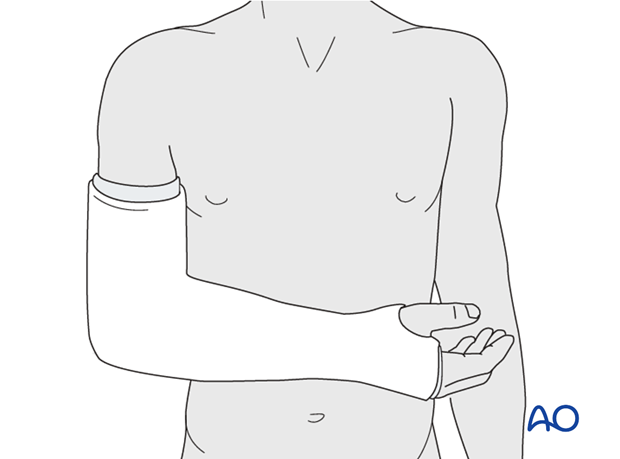Nonoperative treatment
1. General considerations
The only adult forearm shaft fractures in which a satisfactory functional outcome can be expected after nonoperative treatment are minimally displaced, or stably reduced, isolated ulnar fractures with no compromise of either radioulnar joint.
See:
- Mackay D, Wood L, Rangan A (2000) The treatment of isolated ulnar fractures in adults: a systematic review. Injury; 31(8):565-70.
- Sarmiento A, Latta LL, Zych G, et al (1998) Isolated ulnar shaft fractures treated with functional braces. J Orthop Trauma; 12(6):420-3; discussion 423-4.
- Handoll HH, Pearce P (2009) Interventions for isolated diaphyseal fractures of the ulna in adults. Cochrane Database Syst Rev; Jul 8;(3):CD000523.
In all other cases, if nonoperative treatment is necessary because of severe soft-tissue compromise or the patient being unfit for surgery, the functional outcome will inevitably be suboptimal.
The basic principles of nonoperative treatment of adult forearm shaft fractures are:
- Both wrist and elbow joints must be included in the cast
Note: Mackay et al. and Sarmiento & Latta suggest that in isolated ulnar fractures, above elbow splintage is not necessary. - The cast should be well-padded and split along its whole length in any injury where progressive swelling is to be expected
- The general form of the forearm should be restored
- The elbow joint is immobilized in 90° flexion
- The cast should not extend beyond the proximal palmar flexor crease, in order to permit full flexion of the MCP joints of the fingers.
- The thumb should not be included in the cast

Sarmiento and Latta ( Closed Functional Treatment of Fractures, Springer Verlag, 1981, p.384) recommend that the cast be applied with the arm suspended from Chinese fingers traps and the elbow at a right angle. This results in a forearm posture of "relaxed supination": they combine this with careful moulding anteroposteriorly in such a manner as to separate the two bones and tension the interosseous membrane.

Meticulous clinical observation for compartment syndrome must be undertaken. Watch out for increasing inappropriate pain, especially with passive stretching of the muscles of the affected compartment(s).

Additional authorities
- Charnley J (2003) The closed treatment of common fractures. 4th ed. Cambridge University Press.
- Tarr RR, Garfinkel AI, Sarmiento A (1984) The effects of angular and rotational deformities of both bones of the forearm. An in vitro study. J Bone Joint Surg Am; 66(1):65-70.
2. Aftercare following nonoperative treatment
Record of fracture alignment
Document fracture position radiographically after casting, for future reference.
Extension and flexion of the fingers
Start with finger exercises immediately after casting.
Maintain elevation of the limb, paying special attention to pain, especially with passive extension and flexion to the fingers, which could indicate compartment syndrome.

Broad arm sling - collar and cuff sling
A broad arm sling is preferable to a collar and cuff sling.

The collar and cuff can induce ulnar bowing due to cast dropping in the forearm, when the forearm muscles waste.
The ulnar bowing is produced because the wrist is still firmly held by the collar and cuff.

Functional bracing
In relatively simple adult forearm shaft fractures which have had to be treated nonoperatively and which have not displaced on follow-up x-rays, functional bracing might be considered, as a means of enhancing rehabilitation.

Change of treatment method
In occasional cases in which nonoperative treatment was initially indicated for soft-tissue or general medical reasons, the patient’s status may improve to the point that operative treatment can be reconsidered.
Such a decision will need to be made within 3 weeks of injury, beyond which stage satisfactory reduction of such fractures is unlikely to be feasible.













